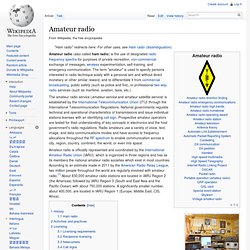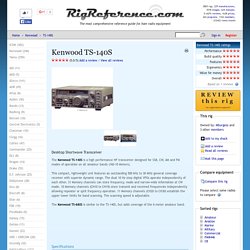

Antenna Links. Amateur radio. An example of an amateur radio station with four transceivers, amplifiers, and a computer for logging and for digital modes.

On the wall are examples of various awards, certificates, and a reception report card (QSL card) from a foreign amateur station. Amateur radio (also called ham radio) is the use of designated radio frequency spectra for purposes of private recreation, non-commercial exchange of messages, wireless experimentation, self-training, and emergency communication. The term "amateur" is used to specify persons interested in radio technique solely with a personal aim and without direct monetary or other similar reward, and to differentiate it from commercial broadcasting, public safety (such as police and fire), or professional two-way radio services (such as maritime, aviation, taxis, etc.).
History[edit] An amateur radio station in the United Kingdom. ARRL - The national association for AMATEUR RADIO. Katy Amateur Radio Society. Kenwood TS-140S Transceiver - RigReference.com. (5.0/5) Add a review / View all reviews Desktop Shortwave Transceiver The Kenwood TS-140S is a high performance HF transceiver designed for SSB, CW, AM and FM modes of operation on all amateur bands (160-10 Meters).

This compact, lightweight unit features an outstanding 500 kHz to 30 MHz general coverage receiver with superior dynamic range. The dual 10 Hz step digital VFOs operate independently of each other. 31 Memory channels can store frequency, mode and narrow-wide information at CW mode. 10 Memory channels (CH10 to CH19) store transmit and received frequencies independently allowing repeater or split frequency operation. 11 Memory channels (CH20 to CH30) establish the upper lower limits for band scanning.
The scanning speed is adjustable. KF5CZO.